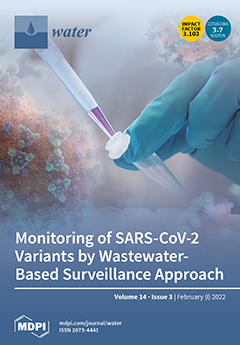As the detection of micropollutants in various water resources is commonly reported, developing an efficient technology to remove them to maintain water safety has become a major focus in recent years. The degradation kinetics of iopromide, one of a group of iodinated X-ray contrast media (ICM), using advanced oxidation processes of ultraviolet/chlorination (UV/Cl
2) and UV/persulfate (UV/PS) oxidation were investigated in this research. The results show that iopromide degradation fitted pseudo-first-order kinetics, and the rate constants were calculated as 2.20 (± 0.01) × 10
−1 min
−1 and 6.08 (± 0.10) × 10
−2 min
−1 in UV/Cl
2 and UV/PS, respectively. In the two systems, the degradation rates were positively correlated with the initial concentrations of HOCl and PS, respectively. In the UV/Cl
2 system, the degradation rate of iopromide reached a maximum at pH 7, while in the UV/PS system, pH had only a slight effect on the degradation rate. Chloride in water had a negligible effect on iopromide degradation, whereas bromide inhibited iopromide degradation in the UV/Cl
2 system. The contributions of UV irradiation, •OH, and RCS to iopromide degradation during UV/Cl
2 treatment were calculated as 20.8%, 54.1%, and 25.1%, respectively. One carbonated and three nitrogenated disinfection by-products (C-DBP (chloroform) and N-DBPs (dichloroacetonitrile, trichloronitromethane, and trichloroacetone)) were detected at relatively high levels, along with three emerging iodinated DBPs (dichloroiodomethane, monochlorodiiodomethane, and triiodomethane). More C- and N-DBPs were generated in the UV/Cl
2 and UV/PS systems than in UV irradiation, while considerably higher I-DBPs were generated in UV irradiation than in the other two systems. Thus, it is essential to pay attention to DBP formation when UV/Cl
2 or UV/PS is used to treat iopromide in water. In order to better control the generation of carcinogenic and toxic I-DBPs, Cl
2 or PS combined with UV should be adopted for iopromide degradation, instead of UV alone, for providing safe drinking water to the public.
Full article





